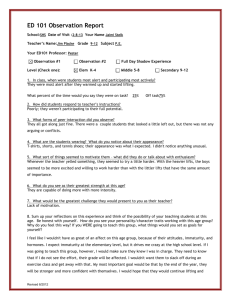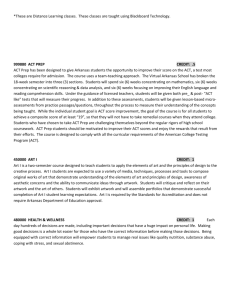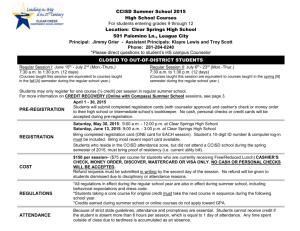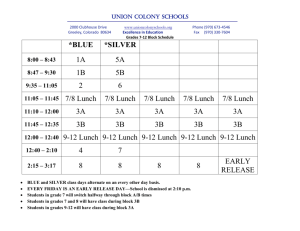9-12.N.1.1.
advertisement
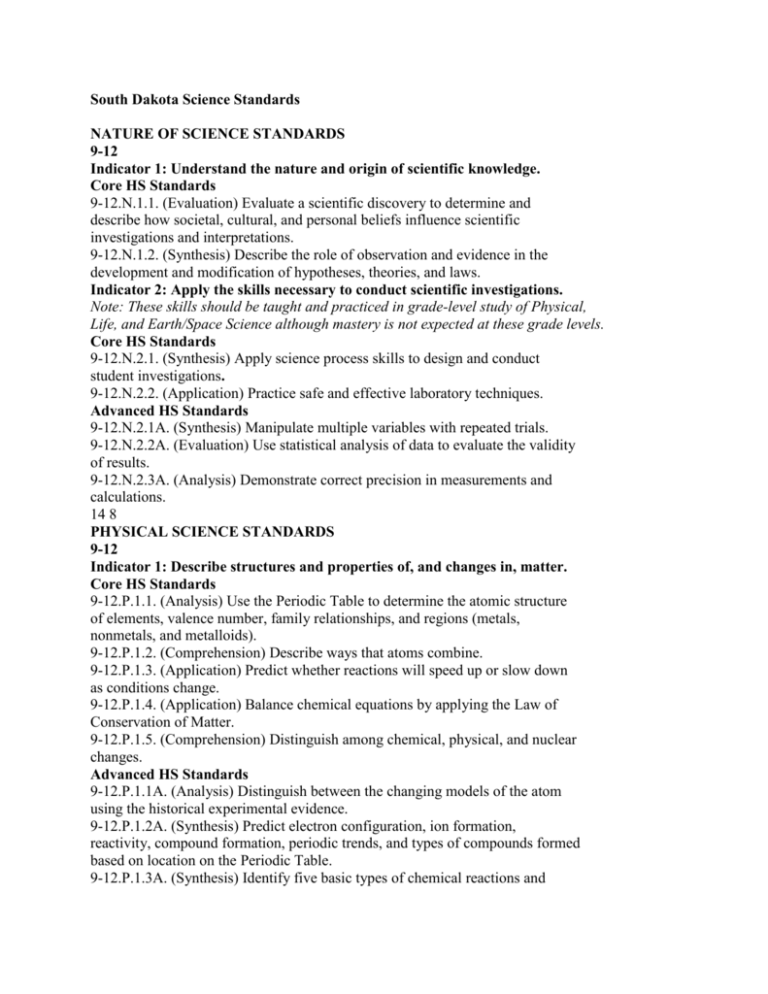
South Dakota Science Standards NATURE OF SCIENCE STANDARDS 9-12 Indicator 1: Understand the nature and origin of scientific knowledge. Core HS Standards 9-12.N.1.1. (Evaluation) Evaluate a scientific discovery to determine and describe how societal, cultural, and personal beliefs influence scientific investigations and interpretations. 9-12.N.1.2. (Synthesis) Describe the role of observation and evidence in the development and modification of hypotheses, theories, and laws. Indicator 2: Apply the skills necessary to conduct scientific investigations. Note: These skills should be taught and practiced in grade-level study of Physical, Life, and Earth/Space Science although mastery is not expected at these grade levels. Core HS Standards 9-12.N.2.1. (Synthesis) Apply science process skills to design and conduct student investigations. 9-12.N.2.2. (Application) Practice safe and effective laboratory techniques. Advanced HS Standards 9-12.N.2.1A. (Synthesis) Manipulate multiple variables with repeated trials. 9-12.N.2.2A. (Evaluation) Use statistical analysis of data to evaluate the validity of results. 9-12.N.2.3A. (Analysis) Demonstrate correct precision in measurements and calculations. 14 8 PHYSICAL SCIENCE STANDARDS 9-12 Indicator 1: Describe structures and properties of, and changes in, matter. Core HS Standards 9-12.P.1.1. (Analysis) Use the Periodic Table to determine the atomic structure of elements, valence number, family relationships, and regions (metals, nonmetals, and metalloids). 9-12.P.1.2. (Comprehension) Describe ways that atoms combine. 9-12.P.1.3. (Application) Predict whether reactions will speed up or slow down as conditions change. 9-12.P.1.4. (Application) Balance chemical equations by applying the Law of Conservation of Matter. 9-12.P.1.5. (Comprehension) Distinguish among chemical, physical, and nuclear changes. Advanced HS Standards 9-12.P.1.1A. (Analysis) Distinguish between the changing models of the atom using the historical experimental evidence. 9-12.P.1.2A. (Synthesis) Predict electron configuration, ion formation, reactivity, compound formation, periodic trends, and types of compounds formed based on location on the Periodic Table. 9-12.P.1.3A. (Synthesis) Identify five basic types of chemical reactions and predict the products. 9-12.P.1.4A. (Synthesis) Describe factors that affect solution interactions. 9-12.P.1.5A. (Application) Examine energy transfer as matter changes. 9-12.P.1.6A. (Application) Perform stoichiometric calculations. 9-12.P.1.7A. (Application) Apply the kinetic molecular theory to solve quantitative problems involving pressure, volume, temperature, and number of 14 9 moles of gas. 9-12.P.1.8A. (Synthesis) Use models to make predictions about molecular structure, chemical bonds, chemical reactivity, and polarity of molecules. 9-12.P.1.9A. (Analysis) Describe the characteristics of equilibria. Indicator 2: Analyze forces, their forms, and their effects on motions. Core HS Standards 9-12.P.2.1. (Analysis) Apply concepts of distance and time to the quantitative relationships of motion using appropriate mathematical formulas, equations, and units. 9-12.P.2.2. (Application) Predict motion of an object using Newton’s Laws. 9-12.P.2.3. (Application) Relate concepts of force, distance, and time to the quantitative relationships of work, energy, and power. Advanced HS Standards 9-12.P.2.1A. (Synthesis) Solve vector problems graphically and analytically. 9-12.P.2.2A. (Analysis) Relate gravitational or centripetal force to projectile or uniform circular motion. Indicator 3: Analyze interactions of energy and matter. Core HS Standards 9-12.P.3.1. (Application) Describe the relationships among potential energy, kinetic energy, and work as applied to the Law of Conservation of Energy. 9-12.P.3.2. (Comprehension) Describe how characteristics of waves are related to one another. 9-12.P.3.3. (Application) Describe electrical effects in terms of motion and concentrations of charged particles. 15 0 Advanced HS Standards 9-12.P.3.1A. (Synthesis) Explain wave behavior in the fundamental processes of reflection, refraction, diffraction, interference, resonance, and image formation. 9-12.P.3.2A. (Application) Describe the relationship between charged particles, static electricity, and electric fields. 9-12.P.3.3A. (Analysis) Describe the relationship between changing magnetic and electric fields. 15 1 LIFE SCIENCE STANDARDS 9-12 Indicator 1: Understand the fundamental structures, functions, classifications, and mechanisms found in living things. Core HS Standards 9-12.L.1.1. (Analysis) Relate cellular functions and processes to specialized structures within cells. 9-12.L.1.2. (Application) Classify organisms using characteristics and evolutionary relationship of major taxa. 9-12.L.1.3. (Analysis) Identify structures and function relationships within major taxa. Advanced HS Standards 9-12.L.1.1A. (Synthesis) Explain the physical and chemical processes of photosynthesis and cell respiration and their importance to plant and animal life. 9-12.L.1.2A. (Synthesis) Describe how living systems use biofeedback mechanisms to maintain homeostasis. 9-12.L.1.3A. (Synthesis) Explain how gene expression regulates cell growth and differentiation. 9-12.L.1.4A. (Application) Identify factors that change the rates of enzyme catalyzed reactions. 9-12.L.1.5A. (Analysis) Classify organisms using characteristics and evolutionary relationships of domains. Indicator 2: Analyze various patterns and products of natural and induced biological change. Core HS Standards 9-12.L.2.1. (Application) Predict inheritance patterns using a single allele. 15 2 9-12.L.2.2. (Synthesis) Describe how genetic recombination, mutations, and natural selection lead to adaptations, evolution, extinction, or the emergence of new species. Advanced HS Standards 9-12.L.2.1A. (Synthesis) Predict the results of complex inheritance patterns involving multiple alleles and genes. Indicator 3: Analyze how organisms are linked to one another and the environment. Core HS Standards 9-12.L.3.1. (Comprehension) Identify factors that can cause changes in stability of populations, communities, and ecosystems. Advanced HS Standards 9-12.L.3.1. (Synthesis) Relate genetic, instinct, and behavior patterns to biodiversity and survival of species. 15 3 EARTH/SPACE SCIENCE STANDARDS 9-12 Indicator 1: Analyze the various structures and processes of the Earth system. Core HS Standards 9-12.E.1.1. (Comprehension) Explain how elements and compounds cycle between living and non-living systems. 9-12.E.1.2. (Application) Describe how atmospheric chemistry may affect global climate. 9-12.E.1.3. (Analysis) Assess how human activity has changed the land, ocean, and atmosphere of Earth. Advanced HS Standards 9-12.E.1.1A (Application) Explain how elements and compounds cycle between living and non-living systems. 9-12.E.1.2A. (Analysis) Compare, quantitatively and qualitatively, methods used to determine geological time. Indicator 2: Analyze essential principles and ideas about the composition and structure of the universe. Core HS Standards 9-12.E.2.1. (Comprehension) Recognize how Newtonian mechanics can be applied to the study of the motions of the solar system. Advanced HS Standards 9-12.E.2.1A. (Analysis) Describe the evidence supporting the Big Bang theory. 9-12.E.2.2A. (Analysis) Describe the physical and nuclear dynamics involved in the formation, evolution, and death of a star. 9-12.E.2.3A. (Application) Describe various ways data about the universe is collected. 15 4 SCIENCE, TECHNOLOGY, ENVIRONMENT, AND SOCIETY STANDARDS 9-12 Indicator 1: Analyze various implications/effects of scientific advancement within the environment and society. Core HS Standards 9-12.S.1.1. (Application) Explain ethical roles and responsibilities of scientists and scientific research. 9-12.S.1.2. (Evaluation) Evaluate and describe the impact of scientific discoveries on historical events and social, economic, and ethical issues. Advanced HS Standards See note below. Indicator 2: Analyze the relationships/interactions among science, technology, environment, and society. Core HS Standards 9-12.S.2.1. (Evaluation) Describe immediate and long-term consequences of potential solutions for technological issues. 9-12.S.2.2. (Analysis) Analyze factors that could limit technological design. 9-12.S.2.3. (Synthesis) Analyze and describe the benefits, limitations, cost, and consequences involved in using, conserving, or recycling resources. Advanced HS Standards See note below.

